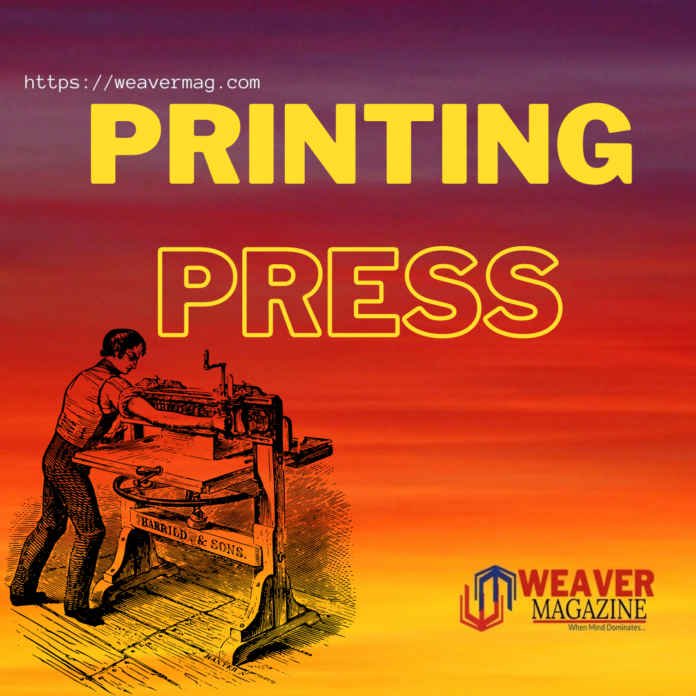PRINTING PRESS
Paper is a versatile sheet of material that is used to write or print literally anything. It is not wrong to call it blessing, as it uses are boundless.Every year 300 million tons of paper is produced. Not surprisiny most of the paper product is used for printing, and writing, which is typically used in schools and offices .
We all tend to take these printed materials for granted, but we can’t begin to imagine our life without these . Newspapers, magazines, catalogs, books, notebooks,commercial ,business forms are all its offshoots.
The invention of printing press was one of the most influential events in second millennium.
Roots of invention of the printing press embarked in China. Following the invention of paper ,the exigency of a machine that transfers text or designs to paper engendered. The Chinese crafted paper with help of bark and bamboo. This modus operandi is later divulged to Europeans and Arabs in thirteen century.
Paper was used as an alternative to the animal skin ,parchment paper and others which served as channel to articulate the written information. Paper became a key figure in spreading literacy.
Prior to the invention of printing press, handwritten copies were used . The drawings, or written documents were mostly written by hand .clay , wax , paraffin wax used to transmit books . Not all folks adhere to this procedure, certain people were assigned , mostly those belonging to monasteries. These had special rooms allotted which is cleped as scriptoriun, where the text is facsimiled from one book to other . Later the drawings were drawn by illuminator.
In bygone ages , not many books were published or known, and those which were published are of religious , pious .
The Chinese were not only acknowledged for introducing paper to the world,but also renowed for pioneering the first printing press. With rudimentary knowledge they built a printing press using ink and blocks . Their manoeuvre was carried out with complete success and helped in publishing few books. But this approach of Chinese did not universalize as much as the European invention did. This was mainly in the view of the fact that it was more of a labor intensive. The western approach was automated one.
The story of evolution of the printing press is long and complex one . Many historians believed that print had an enormous impact socially and politically.
In 1450’s the desideratum for a cheap production arouse. A German goldsmith Gutenberg who is known to the world as inventor of printing press , actually began to set out on a journey to make his livelihood.
At this time the need for documentation proliferated in many sectors of society. Eventhough the monasteries were in charge of documentation, people wanted to have their own private way to print. Correspondingly many new sciptoriums were established. The establishment brought in many employment opportunities to the literate clerks.
The idea of making copies with blocks and ink amused the German goldsmith. This was beginning of the invention.
Eventually , the establishment of numerous monasteries didn’t satisfy the demand of books within time. People needed a machine that would print within less time so as to be able to produce in large amount.
The German goldsmith, thought that developing a printing press would be profit making opportunity. He developed the elemental printing press. His moveable machine used metal blocks that could be moved to print new words and sentences – revolutionising the printer’s craft. He made a marble metal type printing press ,each letter was harnessed on a copper blank and inserted into molten alloy, then antimony and bismuth was poured. Soon it cooled and resulted in reverse image of the letter.
After its huge success in the market, many variations were made to make the print look aesthetic. Soon the size of the letters were adjustable . The production and demand of elegant and sophisticated texts remarkably widespread across the world. Gutenberg signature was his latin print Bible, he embellished the pages with borders and used variety of fonts.
Gutenberg’s invention modified the way information could be publicized. The power of the media in the hands of the people for the first time. Once it came under the hands of the church, the spread of ideas was now in the hands of anyone who could afford a press. These presses played an important role in the spread of ideas that spawned revolutions .
In earlier days oral story telling was common for one person to read out loud to a group of people ,print on other hand , brought personal privacy ,less expensive and portable printed books and made the readers to silent reading not only in the aspect of individual life ,but printing press rapidly became a central to political and religious expression in revolutionary world. The spread if ideas ,visions was a mode of awareness.
Benjamin Franklin, founding father of US, started out as very successful printer. At the age of twenty-two, he opened his own printing shop in Philadelphia. His notable publication was “The Pennsylvania Gazette,” which he purchased in 1729 and made into the most widely-read newspaper in the American colonies.
Years later numerous advancements were made , all improved efficiency of printing press. The texts ,pictures,drawings were all printed with ease.
Some of the history’s notable people appreciated the way the printing press disseminated the information.
” What gunpowder did for war the printing press has done for the mind.” – Wendell Phillips
-BY SHARANYA










